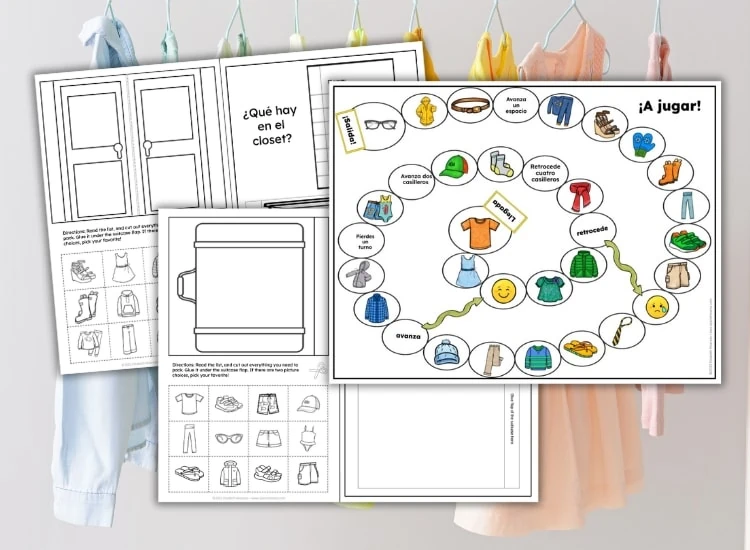The Big List of Spanish Classroom Procedures
Inside: Help for setting up procedures, rules, and management for Spanish teachers.
There are so many things to think through as a teacher. You’re managing objectives, papers, tech, pedagogy… and a big group of students who don’t always want to be there.
Whether you’re a new teacher or a veteran looking for fresh ideas, this post is packed!
Teaching creatively has always come pretty naturally to me. But… the nitty-gritty of management and having consistent routines is much harder!
So this post is written to me as much as to you– the wisdom here comes from the many Spanish teachers I link to and ideas I’ve seen over the years.
Here’s a list of what we’ll cover:
Classroom Procedures:
1. Seating Charts and Desks
2. Entering the Classroom
3. Managing Papers
4. Call and Responses
5. Fast Finishers
6. Bathroom Breaks
7. SSR Procedures
Classroom Policies:
1. Online Translators
2. Student Phones
3. Behavior Expectations
4. Calling Home
5. Student Jobs
6. Staying in the Target Language
Related: 1st Day of Spanish Class Lesson Ideas
Spanish Classroom Procedures
Teachers know that a large part of classroom management is setting up procedures proactively, instead of waiting for problems to arise.
Tell students (and model, and practice) exactly how to enter the room instead of thinking of consequences for a chaotic entrance.
1. Seating Charts
It’s best to start off with seating charts right away, to set the tone that you have a plan and avoid conflict. Rather than making detailed charts right away, Martina Bex has a great post on her simple seating system for the first days in Spanish class, and then the rest of the year.
Another consideration is to move to a deskless classroom, as many teachers have done (I was never allowed… boo.) Here are some links if you’re considering it:
- A list of Pros and Cons from La Maestra Loca
- I’m always up for a Sra. Chase read! The Day I Cried and Then Ditched the Desks
2. Entering the Classroom and Bellwork
If at all possible, greet students at the door, every day. I know we are squeezed for time and I know it’s a scramble between classes!
But it does make a big impact to set the tone for the rest of the period. Making eye contact and speaking to each student establishes both rapport and the idea that you are actively receiving them to your classrom.
To make this easier: have a task they should do upon entering, everyday. My top pick is starting off class with Silent, Sustained Reading (SSR). Reading every day has a big impact on language acquisition, and those calming moments will help you all make the most of class time once you get started.
Students in classes that include time set aside for voluntary reading in the form of sustained silent reading do better than those in similar classes without sustained silent reading on tests of reading comprehension, vocabulary, writing, and grammar.
This is true of first- and second-language studies and holds for children, teenagers, and university students.
– Language Magazine, The Conduit Hypothesis
(Krashen, 2004; 2007; Krashen and Mason, 2017).
Of course, when you have new learners, they aren’t going to be ready for novels quites yet. You can do an “haz ahora” / bellwork as well.
I liked to have my students keep sheets of paper in their notebooks with a grid of squares. Each square was a space for that day’s bellwork, which might be a question, translation, etc. I might have a paragraph from the previous day on the board, for example, and they had to do a detailed drawing of it or a translation.
Every few weeks I would gather up the bellwork sheets for a completion grade. Some teachers manage to check bellwork every day, walking around and marking as students work each morning.
This post from the Deskless Classroom has a PDF with a detailed list on entering and leaving the classroom.
3. Managing Papers
Some tips:
1. Consider giving all students all a class number based on their last names. Then, when your students hand in papers, put them in order (or have a student do it!) this will make entering grades in the grade book easy since they will be in order!
Activity for the second week, when your roster is more established: Have students ask each other’s names in Spanish, figuring how to put themselves in alphabetical order for you. Assign the numbers, and have them mark their number on binders or notebooks.
2. For self-graded papers, I like this tip from Spanish with Stephanie:
I do not pass back self-graded papers! Ninety percent of students will just leave them on the floor or throw them away.
Once I record those grades, I paperclip the assignment together and place it in a bin for that class. No name papers go on top. If a student wants to dispute something in the grade book, I let them go through the stack and find their paper as proof. I recycle each bin at the end of the quarter.
– Spanish with Stephanie
3. Paper for Absent Students: 1-31 System
Hang file folders inside a milk crate, labeled 1-31. When you hand out an assignment and students are absent, drop the leftover papers into the file for that day’s date. Then you’ll easily find them when students are back.
(At the end of the month, clean out all papers and start fresh.)
4. Call and Response
Here are five fun call and response ideas to establish as a routine when you need everyone’s attention:
- Uno, dos tres – ¡No ingles!
- Hola, clase – Hola, profe
- Uno, dos, tres – Cuatro, cinco, seis
- Voy a reír – Voy a bailar – Vivir mi vida – La, la, la, la
See a big list here: Hola, hola, coca-cola and 3o more ideas.
5. Fast Finishers
What do you do with those students who finish everything early? Go ahead and set up a system so no one even needs to ask what they should do next. Some options:
1. Silent Sustained Reading (SSR)
Students who finish early get to read a book from the class library. If it’s available to you, set up a cozy reading corner to encourage students to read.
2. Relax and Color
Let them take some time for zen coloring. I have coloring pages here with quotes from famous Spanish speakers!
3. Tech
Of course, they can also have the privilege of using a device if it’s manageable for you. Let them use an approved sites such as DuoLingo, Quizlet, etc.
6. Bathroom Breaks
This one really depends on your students and context. Here are some ideas:
1. Bathroom Log
Have and sign-in, sign out log by the door that students must sign anytime they leave, along with their reason for leaving.This provides an extra bit of accountability for students who leave (if it’s too much and you need to talk to them/to parents, you have a written record), and in case of emergency you know where students are at all times.
2. Bathroom Passes
Give a certain number of passes (most teachers do 3-4) per semester, with student names on them. At the end of the semester, collect unused passes for extra credit.
3. Trade Phones for Bathroom Passes
If a student needs to use the bathroom, require them to leave their phone before leaving. This is a good way to ensure the trip will be quick and not used for anything else!
7. SSR / FVR
Wondering how to manage reading time in class? Bryce Hedstrom simply has the clearest advice on setting it up and communicating about it with students.
1. This page outlines everything you need to know: selecting books, teaching students how to read, routines, all of it.
2. Questions about FVR from Bryce Hedstrom. This post is great because he links to a bunch of quick posters and a Friday reflection sheet, in case you want your students to write about their books once a week.
Spanish Classroom Policies
1. Translators
Most of the problems with translators come from assigning homework or projects that involve writing. In my opinion, the basic solution is simply to have almost all writing take place in class– this is the only way for you to truly know their proficiency level for writing.
There are some tools for limiting websites that students can access while working on school devices (of course, some students may figure out how to hack the system):
- GoGuardian
- Hapara
You also can point out to students that Google translate is good but still faulty. There are some funny YouTube videos on this (Fresh Prince of Bel Air Google Translate video, Let It Go according to Google Translate, etc.)
I speak Spanish everyday in my daily life, and yet I still use online translators to refine or check my writing. They’re a part of life now, and every year they get more accurate.
I think it’s best to accept that students will have access to them in the real world (and we can give them tips for how to use online tools, as a skill), and simply keep writing tasks in-class. Writing as a presentational skill is going to be forever affected by online tools, so we have to keep that in mind going forward.
2. Student Phones
This one is huge, I know. Your classroom policy will obviously depend on your school/district. My ideal school would have a schoolwide no-devices policy, in which confiscated devices must be collected by parents from the front office. HOWEVER, most of us have to develop our own policy! Within those parameters, here are some options:
1. Have a phone hotel.
Use the plastic shoe holder and require students to place their phones in the holder upon entering class.
2. Require phones to be put away.
Your policy could be that a) phone are in backpacks, and b) backpacks are under the student’s chair/desk.
3. The envelope system.
Some teachers do not want to confiscate or touch student phone and open themselves up to problems there. With envelopes, anytime you see a student phone you give them an envelope. The students places their phone inside, seals it, and it sits on their desk until the end of class.
4. Charging Station
Create a place with multiple outlets where students can charge their devices.
3. Behavior Expectations in Spanish Class
1. For managing behavior, I just want to send you right away to Jon Cowart. He outlines his advice for the language classroom in this post, and it’s better than anything I could say. The paragraphs on expectations, being explicit and concise in directions, and behavior narration are gold. Sometimes I think I’m clear (you should be respectful! ) when I haven’t taken the time to be very clear of what that looks like in my room.
2. I also love this advice from La Maestra Loca, Annabelle Williamson. She talks about having percentages posted on the room, so you can easily indicate where they are on participation or a certain behavior you have asked from them, instead of where you need them to (100%).
For example: if you’re not getting a full choral response from every single kid (or a question or the stop/clarify signal) then you point to the percent who are doing it and show that you need to have 100% participation.
This is based on the classroom management technique where you say, “I have 50% [of the class]” or “I’m waiting on five people” It works well. I believe it’s called narrating the positive. Basically if you have procedures/expectations/instructions as soon as someone does what they’re supposed to do you immediately narrate out loud to the class what they did. It’s a way of calling the others out without actually calling them out. Students usually get on task when they hear the positive praise for the person who did what they were supposed to do.
– Annabelle Williamson
3. Here is another good read from Jen at Spanish with Sra. Shaw. She share some tools and tips from a down-to-earth perspective that I really appreciate!
4. What if it’s the middle of the year and things have kind of devolved? Here’s a good read on how to do a mid-year reset.
Related: 14 Keys to Classroom Management
Again, hopefully your district has a fair, clear plan and all the teachers are on board together. Here are some blog posts I found helpful when you need a reset or a re-think through your in-class consequences and rewards. (Calling home may be a big piece of that, so you may want to see the next section!)
The Timer Trick
Read from Sra. Chase on setting a timer to accumulate points for game-time in class.
Tips for The Elementary Spanish Classroom:
5. Calling Parents
I get it- I hate phone calls. And yet, now that my own kids are in elementary grades and moving onto secondary, I see it from the other side and so appreciate the contact from teachers. Here are some tips:
1. Erin from The Engaged Spanish Classroom has a nice tip about this:
I say do it at the end of your prep period if you feel cramped for time, because you can limit your phone time. If the phone conversation starts to run long, you have a firm end coming. “That’s the bell and I have students coming in! I wanted to make sure you knew how impressed I was lately with ________’s effort. Have a great night!”
– The Engaged Spanish Classroom
2. I also like this encouragement from Profesora Delgadillo (the whole blog post has some good tips on Spanish classroom management.
My first years of teaching, calling parents was so intimidating because I am such a non confrontational being, but what helped me get out of that mindset was to prepare my script before I called, and over time, I got a lot better at it.
The phone call is one of our first and most powerful lines of defense when preserving an effective and safe learning environment.
I also used to feel so bad for getting my learners in trouble when I was a brand new teacher, now I really don’t care. For anyone who disrupts the learning of others and disturbs my mental peace, there will be consequences, and I will not feel bad about it. This is part of being firm.
– Old School Classroom Management from Profesora Delgadillo
6. Student Jobs
Let me direct you to Bryce Hedstrom for this one! On his free stuff page, the third heading is classroom jobs and he has a quick PDF with descriptions if you want to assign jobs. They are specific to the world language classroom too. Honestly, I never was quite organized to stay on top of assigning jobs, but I think they are a good idea!
La Maestra Loca also has a great post on classroom jobs and how to take the time to set them up for a smoother year. I appreciated her explanation that it feels like more work at the beginning but can pay off big time throughout the year.
7. Staying in the TL
What strategies can you implement to hit your goal of Spanish spoken each classes? And to make sure it’s not noise to your students? Browse these suggestions and frameworks:
1. Series from Claudia Elliot on Sticking to the TL in Spanish class. Here’s an interview with Diane Neubauer as well (answering your burning questions about the TL use in class).
2. Here are two excellent interviews (the first is with Alina Filipescu and Jason Fritze):
3. A conversation on staying in the TL with Rebecca Blouwolff, the NECTFL 2019 teacher of the year:
4. 90% Target Language Use in the Elementary Classroom:











